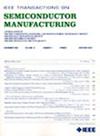ml引导的曲线OPC:快速,准确和可制造的曲线校正
IF 2.3
3区 工程技术
Q2 ENGINEERING, ELECTRICAL & ELECTRONIC
引用次数: 0
摘要
在曲线光学接近校正(OPC)中,每一段由两个端点和两个中间点定义的三次bsamizier曲线建模。这些点的迭代校正不是微不足道的,并且已经使用了简单的启发式(Chen et al., 2024),但并不有效。首次引入顶点放置误差(VPE)来代替标准曼哈顿OPC中的边缘放置误差(EPE)。采用两种机器学习模型进行精确的曲线校正。(1)使用MLP定位新端点,同时提供前一次迭代的VPE和一些表示局部光强的PFT信号作为输入。(2)使用GCNs构建的VPE预测器设计用于在给定布局剪辑上输出平均(或最大)VPE。训练完成后,用于MLP固定新端点后的中间点识别;这是通过梯度下降优化来实现的,这样VPE最小化,曲率约束尽可能得到尊重。实验结果表明,当以平均VPE为目标时,所提出的曲线OPC将OPC迭代从8次减少到5次,当以最大VPE为目标时,将OPC迭代从14次减少到5次,最终的VPE减少约5% ~ 6%。本文章由计算机程序翻译,如有差异,请以英文原文为准。
ML-Guided Curvilinear OPC: Fast, Accurate, and Manufacturable Curve Correction
In curvilinear optical proximity correction (OPC), each segment is modeled by a cubic Bézier curve, defined by two endpoints and two intermediate points. Iterative correction of these points is not trivial, and a simple heuristic (Chen et al., 2024) has been used but is not effective. A vertex placement error (VPE) is first introduced to replace edge placement error (EPE) in standard Manhattan OPC. Two machine learning models are applied for accurate curve correction. (1) An MLP is used to locate the new endpoints, while VPE from the previous iteration and a few PFT signals representing local light intensity are provided as inputs. (2) A VPE predictor, constructed with GCNs, is designed to output average (or maximum) VPE over a given layout clip. Once trained, it is used to identify intermediate points after new endpoints are fixed by MLP; this is done through gradient descent optimization such that VPE is minimized and curvature constraints are respected as much as possible. Experimental results demonstrate that the proposed curvilinear OPC reduces OPC iterations from 8 to 5 when average VPE is considered as a target or from 14 to 5 when maximum VPE is a target, with a final VPE reduction of about 5 to 6%.
求助全文
通过发布文献求助,成功后即可免费获取论文全文。
去求助
来源期刊

IEEE Transactions on Semiconductor Manufacturing
工程技术-工程:电子与电气
CiteScore
5.20
自引率
11.10%
发文量
101
审稿时长
3.3 months
期刊介绍:
The IEEE Transactions on Semiconductor Manufacturing addresses the challenging problems of manufacturing complex microelectronic components, especially very large scale integrated circuits (VLSI). Manufacturing these products requires precision micropatterning, precise control of materials properties, ultraclean work environments, and complex interactions of chemical, physical, electrical and mechanical processes.
 求助内容:
求助内容: 应助结果提醒方式:
应助结果提醒方式:


